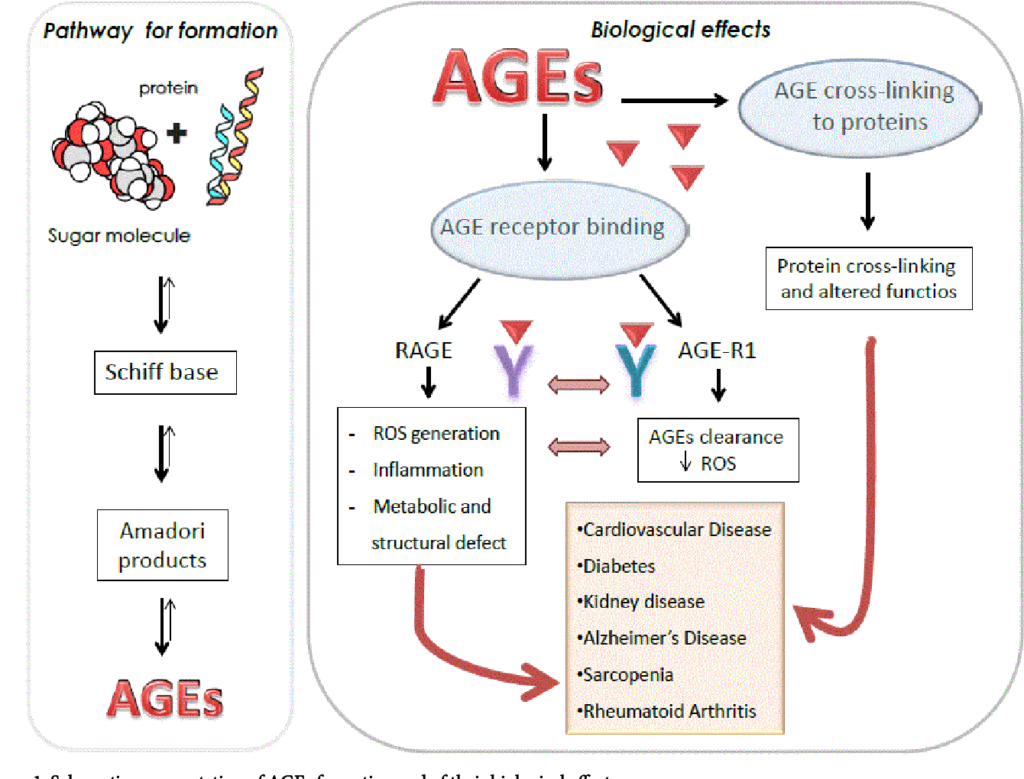Hi, my friend! Today I have decided to explain to you what AGE is. No, it’s not an aging process it contributes to that significantly though. AGE is short for Advanced Glycation End product. When we consume sugar, means sugary, carbohydrate kinds of stuff, turns out, that even a small amount of it floating thru the bloodstream, gets us into a lot of trouble. Same as sugar as we know it is sticky outside and behaves the same way inside our blood. It attache to itself to tissues and other structures where it’s not needed. This precipitates a slow and very destructive condition. Glucose sticks to everything that makes contact with it. Proteins, lipids, DNA, collagen, etc. Another condition for glycation is oxidative stress. Free radicals, both oxygen and carbonyl species, accelerate the sticky sugar problem. The bonding of sugar to this stuff creates even more free radicals in this process and creates a vicious cycle. So, in summary, a combination of sugar (glucose or fructose), latching onto a molecule under oxidative stressful conditions creates AGE. The more AGE you have, the more aged you have become. Under normal conditions, the formation of the AGEs can take weeks to months and tend to affect longer-lived substrates, collagen for example. Under pathological conditions such as high glucose availability, increased temperature, and oxidative stress, the reactions can occur over hours and also affect short-lived molecules like hormones and enzymes.

Protein AGE
As we can see a standard product we have been talking about called AGE is when protein is attached to sugar. When substrates change to sugar-lipid then we talk about ALE (Advanced Lipid End product). When this attachment is with DNA molecules we talk about DNA-AGEs. Important is though, though, is glucose attached to the activity of that substance is essentially lost. Seems like the sugar-protein bond is the biggest problem. Glucose has a propensity for particular amino acids in protein but Lycine is like a special magnet for glucose. There is a test to measure AGE in your body but it’s very expensive and that’s why there are not many places to do that out there. On the other hand, we can measure something else. Because all proteins are coated by AGE in plasma, from serum Albumin to immunoglobulins, we can choose one and measure it. One of these is a common test for all labs. It’s HgA1C or Hemoglobin A1C. Everybody has glycated Hemoglobin to a certain degree. The point is to get it as low as possible to prolong our life. Let’s look at special proteins such as Elastin and Collagen. These are in the skin, bones, and especially blood vessels. They provide strength and flexibility in our arteries, etc. Collagen provides the structural framework, while Elastin is the extensibility. Collagen can stretch about 10%, while Elastin about 200%. Because AGE affects these over time we get arterial stiffening, causing high blood pressure, and decreased blood delivery to the necessary organs. This happens to everybody in the end but to people with diabetes, a lot sooner and on a bigger scale. So once nice and beautiful skin loses its elasticity and its ability to retain shape. You can even do your own pinch test. Pinch your skin for 5 seconds. The time it takes to return to normal is supposed to predict your functional age. We can see now how detrimental AGE is.
DNA AGE
Sugar DNA damage includes single and double-stranded breaks, and mutations as insertions, deletions, and transpositions. This happens as the affected DNA gets partially unwound, allowing the double-helix structure to become fragmented. Science geeks might know of the four base pairs found in DNA, the guanosine exhibits the highest rate of glycation.
AGE-R1, AGE-R2, RAGE
Not only these harmful molecules floating around attacking everything, but scientists have also identified cellular receptors that they bind to and inflict more cellular damage. Located in tissues as varied as the heart, lung, and askeletal muscle, these receptors are also found on individual cells such as macrophages, adipocytes, and endothelial cells in blood vessel walls. For now, we have identified three of them AGE-R1, AGE-R2, and RAGE but, with time there will be probably more. One of two things can happen when AGE complexes with the cell’s receptor. The first is actually a good one. The AGE is incorporated by the cell and systematically destroyed but most of the time the second thing occurs which is a worse scenario. The AGE lands on the receptor and triggers destructive processes. It triggers the inflammatory cascade by activating the Nuclear factor-κβ (NF-κβ). This then initiates a feedback loop whereby increased NF leads to an increase in the RAGEs, leading to an even higher level of inflammation. RAGE activation of endothelial cells (inner lining of the blood vessels) triggers an increased permeability of the blood vessel wall. This leaking allows fluid to escape into the tissues, causing edema, and also allows lipids to get into the wall, which is considered the first step to atherosclerosis. RAGE activation on platelets and white blood cells also triggers the production of most inflammatory factors IL-1 (Interleukin-1), TNF-α (Tumor Necrosis Factor-α), platelet-derived growth factor, Insulin-like Growth Factor, etc
In addition to this, internally made AGE, we also consume or ingest premade AGEs as well. We inhale their precursors from cigarette smoke and they are also present in foods. Of the total AGE, ingestion is estimated that we absorbed about 10-30% in our GI tract, and of these 2/3 are deposited into tissues.
High AGE food preparation:
1. Highly heated, processed foods
2. Any food cooked to browning
3. High lipid and protein foods
4. Dry heat cooking techniques: fermenting, grilling frying, roasting, baking, barbecuing, etc.

That’s why experts recommend cooking at lower temperatures, longer time, and using more water (boiling, poaching, steaming). To fight AGE is also good to know fructose is 7,5 times more reactive than glucose. Our bodies are able to get rid of a lot of AGEs thru urination but people with kidney issues cannot. We are also able to break down AGE way called extracellular proteolysis, meaning that outside of the cells, enzymes are roaming around that can reverse the process if caught early. There are also receptors for AGEs on specific cells that cause the AGE to be taken inside the cell and degraded into smaller pieces. The remnants, called second-generation AGEs, which are low molecular weight soluble peptides, are then transported to the kidney and excreted.
So, how do I fight AGE? I avoid sugar as a plague, I’m on a low-carb diet. I don’t cook food very much (low processed food) and I try to eat as much raw as possible. I exercise which lowers blood sugar and that’s why AGE as well. I do fasting which lowers blood sugar as well (it’s not a brainer). I also use my exogenous agents to clean up my body from AGE as much as possible and my favorite one, in this case, is Pyridoxamine. There was a lot of info for you today so get rest and think about how to improve your life to be healthier. See you next time





